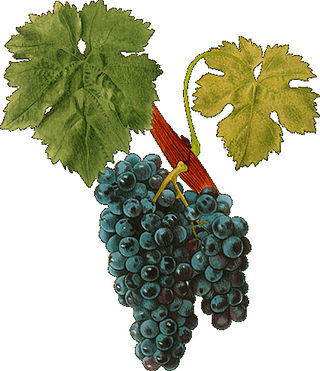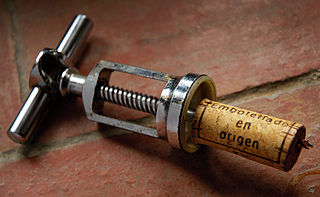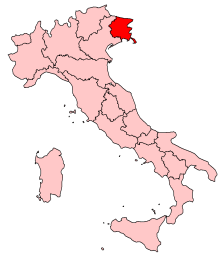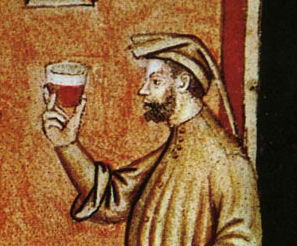Related Research Articles

Sparkling wine is a wine with significant levels of carbon dioxide in it, making it fizzy. While it is common to refer to this as champagne, European Union countries legally reserve that word for products exclusively produced in the Champagne region of France. Sparkling wine is usually either white or rosé, but there are examples of red sparkling wines such as the Italian Brachetto, Bonarda and Lambrusco, and the Australian sparkling Shiraz. The sweetness of sparkling wine can range from very dry brut styles to sweeter doux varieties.

Carignan is a red grape variety of Spanish origin that is more commonly found in French wine but is widely planted throughout the western Mediterranean and around the globe. Along with Aramon, it was considered one of the main grapes responsible for France's wine lake and was a substantial producer in jug wine production in California's Central Valley but in recent years, it has been reborn as a flagship wine for many cellars in the south of France as well as in Catalonia.

Grappa is an alcoholic beverage: a fragrant, grape-based pomace brandy of Italian origin that contains 35 to 60 percent alcohol by volume. Grappa is a protected name in the European Union.

Chaptalization is the process of adding sugar to unfermented grape must in order to increase the alcohol content after fermentation. The technique is named after its developer, the French chemist Jean-Antoine-Claude Chaptal. This process is not intended to make the wine sweeter, but rather to provide more sugar for the yeast to ferment into alcohol.

Greece is one of the oldest wine-producing regions in the world and among the first wine-producing territories in Europe. The earliest evidence of Greek wine has been dated to 6,500 years ago

French wine is produced all throughout France, in quantities between 50 and 60 million hectolitres per year, or 7–8 billion bottles. France is one of the largest wine producers in the world, along with Italian, Spanish, and American wine-producing regions. French wine traces its history to the 6th century BCE, with many of France's regions dating their wine-making history to Roman times. The wines produced range from expensive wines sold internationally to modest wines usually only seen within France such as the Margnat wines of the post war period.

Spanish wine includes red, white, and sparkling wines produced throughout the country. Located on the Iberian Peninsula, Spain has over 1.2 million hectares planted in wine grapes, making it the most widely planted wine-producing nation, but the second largest producer of wine in the world, behind Italy and ahead of France and the United States. This is due, in part, to the very low yields and wide spacing of the old vines planted on the dry soils found in some of the Spanish wine regions. The country is ninth in worldwide consumption with Spaniards drinking, on average, 21.6 litres per person a year. The country has an abundance of native grape varieties, with over 400 varieties planted throughout Spain, though 88 percent of the country's wine production is from only 20 grapes — including the reds Tempranillo, Bobal, Garnacha, and Monastrell; the whites Albariño, Airén, Verdejo, Palomino, and Macabeo; and the three Cava grapes Parellada, Xarel·lo, and Macabeo.
The glossary of wine terms lists the definitions of many general terms used within the wine industry. For terms specific to viticulture, winemaking, grape varieties, and wine tasting, see the topic specific list in the "See also" section below.

The following outline is provided as an overview of and topical guide to wine:

Languedoc-Roussillon wine, including the vin de pays labeled Vin de Pays d'Oc, is produced in southern France. While "Languedoc" can refer to a specific historic region of France and Northern Catalonia, usage since the 20th century has primarily referred to the northern part of the Languedoc-Roussillon region of France, an area which spans the Mediterranean coastline from the French border with Spain to the region of Provence. The area has around 700,000 acres (2,800 km2) under vines and is the single biggest wine-producing region in the world, being responsible for more than a third of France's total wine production. In 2001, the region produced more wine than the United States.

The Cypriot wine industry ranks 50th in the world in terms of total production quantity, and much higher on a per-capita basis. The wine industry is a significant contributor to the Cypriot economy through cultivation, production, employment, export and tourism.

Quality wines produced in specified regions is a quality indicator used within European Union wine regulations. The QWpsr category identifies wines with protected geographical indications and protected designations of origin. The European Union regulates and defines the status of "quality wines" according to production method, management, and geographical location. Its original, fundamental role is in differentiating quality wines from table wines, broadly in line with the system traditionally employed by the French government, amended to account for the preferences and methodology of Italian, German, and other growers in the EU.

Catalan wines are those that are produced in the wine regions of Catalonia. Occasionally, the appellation is applied to some French wine made in the Catalan region of Roussillon and neighboring areas, also known as Northern Catalonia or the Pays catalans. The city of Barcelona is the capital of Catalonia and despite not being in a wine region, it is the focal point of the Catalan wine industry: a primary consumer market, its port provides export functions and a source of financial resources and investment. The Penedès is the largest wine-making region in Catalonia.

Friuli-Venezia Giulia wine is wine made in the northeastern Italian region of Friuli-Venezia Giulia. There are 11 denominazione di origine controllata (DOC) and 3 denominazione di origine controllata e garantita (DOCG) in the Friuli-Venezia Giulia area. The region has 3 indicazione geografica tipica (IGT) designations Alto Livenza, delle Venezie and Venezia Giulia. Nearly 62% of the wine produced in the region falls under a DOC designation. The area is known predominantly for its white wines, which are considered some of the best examples of Italian wine in that style. Along with the Veneto and Trentino-Alto Adige, the Friuli-Venezia Giulia forms the Tre Venezie wine region, which ranks with Tuscany and Piedmont as Italy's world class wine regions.

Slovenia has more than 28,000 wineries making between 80 and 90 million litres annually from the country's 22,300 ha of vineyards. About 75% of the country's production is white wine. Almost all of the wine is consumed domestically with only 6.1 million L a year being exported—mostly to the United States, Bosnia and Herzegovina, Croatia, and lately the Czech Republic. Most of the country's wine production falls under the classification of premium (vrhunsko) wine with less than 30% classified as basic table wine (namizno vino). Slovenia has three principal wine regions: the Drava Wine-Growing Region, the Lower Sava Wine-Growing Region, and the Littoral Wine-Growing Region.
Wine laws are legislation regulating various aspects of production and sales of wine. The purpose of wine laws includes combating wine fraud, by means of regulated protected designations of origin, labelling practices and classification of wine, as well as regulating allowed additives and procedures in winemaking and viticulture. Legislation affecting all kinds of alcohol beverages, such as the legal drinking age and licensing practices related to distribution and sales, are usually not considered wine laws.

Corsica wine is wine made on the Mediterranean island of Corsica. Located 90 km west of Italy, 170 km southeast of France and 11 km north of the island of Sardinia, the island is a territorial collectivity of France, but many of the region's winemaking traditions and its grape varieties are Italian in origin. The region's viticultural history can be traced to the island's settlement by Phoceans traders in 570 BC in what is now the commune of Aléria. In the 18th century, the island came under the control of France. Following the independence of Algeria from French rule, many Algerian Pieds-Noirs immigrated to Corsica and began planting vineyards. Between 1960 and 1976 the vineyard area in Corsica increased fourfold. In 1968, Patrimonio was established as Corsica's first Appellation d'origine contrôlée (AOC). Today, Corsica has nine AOC regions including the island-wide designation Vin de Corse AOC. The majority of the wine exported from Corsica falls under the Vin de pays designation Vin de Pays de l'Île de Beauté. The three leading grape varieties of the region are Nielluccio (Sangiovese), known as the spice wine of France, Sciacarello and Vermentino.

A winemaking cooperative is an agricultural cooperative which is involved in winemaking, and which in a similar way to other cooperatives is owned by its members. The members in a winemaking cooperative are usually vineyard owners, who deliver grapes to the cooperative, which is involved in production of wine from the grapes and the subsequent marketing activities.
European Union wine regulations are common legislation related to wine existing within the European Union (EU), the member states of which account for almost two-thirds of the world's wine production. These regulations form a part of the Common Agricultural Policy (CAP) of EU, and regulate such things as the maximum vineyard surface allowed to individual EU member states, allowed winemaking practices and principles for wine classification and labelling. The wine regulations exist to regulate total production in order to combat overproduction of wine and to provide an underpinning to Protected designations of origin (PDOs), among other things. In a sense, the wine regulations therefore try to protect both the producer and the consumer.

Old World wine refers primarily to wine made in Europe but can also include other regions of the Mediterranean basin with long histories of winemaking such as North Africa and the Near East. The phrase is often used in contrast to "New World wine" which refers primarily to wines from New World wine regions such as the United States, Australia, South America and South Africa. The term "Old World wine" does not refer to a homogeneous style with "Old World wine regions" like Austria, France, Georgia, Italy, Portugal, and Spain each making vastly different styles of wine even within their own borders. Rather, the term is used to describe general differences in viticulture and winemaking philosophies between the Old World regions where tradition and the role of terroir lead versus the New World where science and the role of the winemaker are more often emphasized. In recent times, the globalization of wine and advent of flying winemakers have lessened the distinction between the two terms with winemakers in one region being able to produce wines that can display the traits of the other region—i.e. an "Old World style" wine being produced in a New World wine region like California or Chile and vice versa.
References
- ↑ Jancis Robinson (ed) "The Oxford Companion to Wine" Third Edition p. 261. Oxford University Press 2006 ISBN 0-19-860990-6.
- ↑ Council Regulation (EC) No 479/2008 of 29 April 2008 on the common organisation of the market in wine - Annex IX: Wine-growing zones.
- ↑ Council Regulation (CE) No 1493/1999 of 17 May 1999 on the common organisation of the market in wine - Annex III: Wine-growing zones.